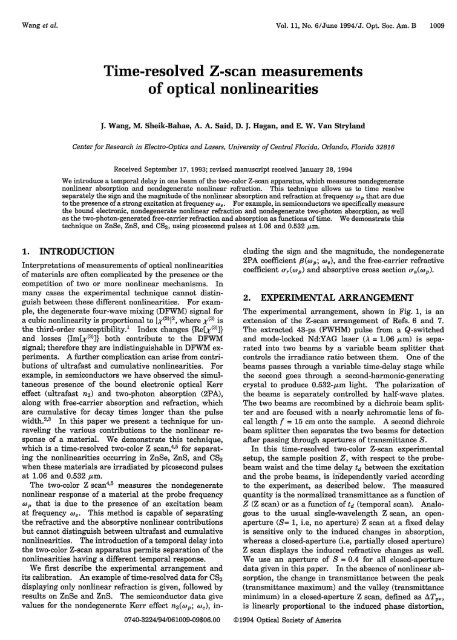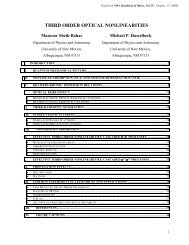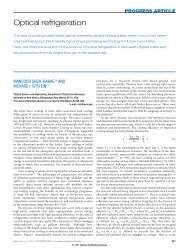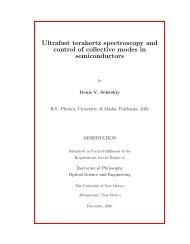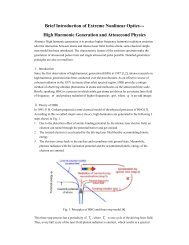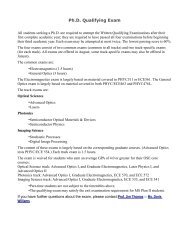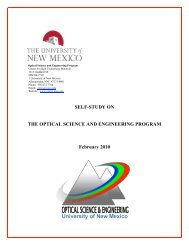Time-resolved Z-scan measurements of optical nonlinearities
Time-resolved Z-scan measurements of optical nonlinearities
Time-resolved Z-scan measurements of optical nonlinearities
Create successful ePaper yourself
Turn your PDF publications into a flip-book with our unique Google optimized e-Paper software.
Wang et al.where d is the distance between the position <strong>of</strong> the focalpoint <strong>of</strong> the excitation beam and the aperture plane andJo is the Bessel function <strong>of</strong> zeroth order. The normalizedtransmittance is given byf dtf rdrEal2T(td, Z) = fJ d ° 0 (10)Jdtfo rdrlEa(I, = 0)12where ra is the aperture radius that for an open-apertureZ <strong>scan</strong> is infinite. It is more convenient to specify theaperture transmittance S = 1 - exp(-2ra 2 /Wa 2 ), where Wais the beam radius at the aperture in the linear regime.Under certain conditions Eqs. (4)-(10) can be solvedanalytically, but in general a numerical solution isrequired. 2 3 In the analysis <strong>of</strong> time-<strong>resolved</strong> data, thequantities ATpv and Top, as a function <strong>of</strong> the time delaytd, are calculated with Eq. (10):A Tpv (td) = [T(td, Z,) _ T(td, Zv) for S < 1,Tp(td, Z,) Tp(td, Zv)T 0 p(td) = T(td, 0) with S = 1,(11)where Z, and Z, are the positions <strong>of</strong> peak and valley <strong>of</strong>the Z <strong>scan</strong>, respectively. The sign <strong>of</strong> ATpv is given bythe sign <strong>of</strong> Z, - Z,.As discussed in Section 4, the spatial separation betweenpeak and valley, ATpv, depends on the order <strong>of</strong> thenonlinearity equaling 1.7zo for a third-order responseand 1.2zo for a fifth-order nonlinearity. Thus, in performinga temporal <strong>scan</strong>, one can optimize the signal fora third- or a fifth-order nonlinearity, although the differencein signal is only approximately 20%. This must beaccounted for in interpreting the results <strong>of</strong> a temporal<strong>scan</strong> when both types <strong>of</strong> nonlinearity are present.Vol. 11, No. 6/June 1994/J. Opt. Soc. Am. B 10134. RESULTS AND DISCUSSIONThe semiconductor samples used in our experiments arezinc blende polycrystalline slabs <strong>of</strong> ZnSe and CleartranZnS. ZnSe has a band-gap energy <strong>of</strong> Eg = 2.6 eV, 24no = 2.5 at A = 1 zm, and no = 2.7 at A = 0.5 ,um. Thesample thickness is 2.7 mm. The ZnS sample has athickness <strong>of</strong> 1 mm, Eg = 3.7 eV, 24 no = 2.3 at 1 um, andno = 2.4 at 0.5 ,um. In the following discussion, refersto 1.06-,utm light and 2 to 0.532-,um light. Table 1summarizes the results described below.A. Excitation at 1.06 gLmIn both ZnSe and ZnS, degenerate 2PA with A = 1.06 ,umis energetically forbidden (i.e., 2kW < Eg). Therefore,with the strong excitation beam at 1.06 Am, the freecarrierdensity (AN) remains small, and the inducedAn and Aa are dominated by ultrafast bound electroniceffects. However, in experiments on both polycrystallineZnSe and ZnS, scattered second-harmoniclight at 532 nm could be seen. Hence care was taken toensure that second-order effects 2 5 did not influence ourresults. In ZnSe the probe at A = 532 nm experiencesa nondegenerate 2PA because h + 1w = 3.5 eV exceedsthe band-gap energy <strong>of</strong> ZnSe. The open-aperture andclosed-aperture Z-<strong>scan</strong> data at zero temporal delay, obtainedwith an excitation irradiance (Ie) <strong>of</strong> 0.7 GW/cm 2 ,are shown in Fig. 3. Measurements were made for twocases <strong>of</strong> parallel-polarized (xx) and crossed-polarized(xy) excitation and probe beams. From the calculations,the best fits give 63x 2 (w; W) = 15 ± 3 cm/GW,f8xx(2W; ,/13xY(2W,; W) = 1.7 ± 0.4, n 2 xx(2Wo; w) = - (5.1 ±1.0) X 10-14 cm 2 /W, and n 2 XX (2Wo;w)/n2xY ( 2 co; ) =2.0 ± 0.5 (see Table 1). All the results in Table 1 referto parallel polarization unless specifically noted withthe superscript xy. The observed polarization dichroismhas been attributed to the interference between contributionsto X(3) from the heavy-hole and the light-holevalence bands. 2 6For ZnS with h + 2h < Eg, nondegenerate2PA is not permitted, and the measured <strong>nonlinearities</strong>are purely refractive (degenerate 2PA forthe probe at 532 nm is weak). Figure 4 shows theTable 1. Nondegenerate Nonlinear Parameters Extracted from the <strong>Time</strong>-ResolvedTwo-Color Z-Scan DataaMaterialParameter ZnSe ZnS/8 (1.06; 1.06) 0 0/3 (0.532;0.532) 5.8 ± 1 cm/GW 3.4 ± 0.7 cm/GW,8 (0.532; 1.06) 15 ± 3 cm/GW 0,G(1.06;0.532) 4.6 ± 1 cm/GW 0,BXy(1.06;0.532) 8.6 ± 2 cm/GW 0n2 (1.06; 1.06) (2.9 ± 0.3) 10-1 4 cm 2 /W (6.3 ± 1.4) 10-1 5 cm 2 /Wn2 (0.532; 0.532) (-6.8 ± 1.4) 10-14 cm 2 /W Not measuredn2 (0.532; 1.06) (-5.1 ± 0.5) x 10-1 5 cm 2 /W (1.7 ± 0.4) 10-1 4 cm 2 /Wn 2 XY (0.532; 1.06) (-2.6 ± 0.3) 10-14 cm 2 /W Not measuredn2 (1.06; 0.532) (-9 ± 5) 10-1 5 cm 2 /W
1014 J. Opt. Soc. Am. B/Vol. 11, No. 6/June 1994a)U 1.2C-0E- 0.4_* Dv0.26 -4 -2 0 2 4 iZ/Zodata (open circles) for ZnSe obtained with perpendicularly polarizedbeams at zero time delay (excitation at 1.06 um and probeat 0.532 ,in). The squares show the division <strong>of</strong> the two datasets, and the curves represent theoretical fits.1.40)c-,C._cE 1.2s)CH-a0 1.0N00 z'0 . 80Z/ZoFig. 4. Closed-aperture degenerate Z-<strong>scan</strong> data (filled circles)and closed-aperture nondegenerate data (open circles) obtainedwith excitation at 1.06 ttm and probe at 0.532 ,um for ZnSobtained with parallel-polarized beams at zero time delay. Thecurves represent theoretical fits.closed-aperture Z-<strong>scan</strong> signal compared with thesingle-wavelength Z <strong>scan</strong> at 1.06 ,um measured atI, = 8.5 GW/cm 2 . The best fit to these data gives a ratio<strong>of</strong> n 2 (2w; w)/n 2 (W; W) 1.9 + 0.2 for parallel-polarizedbeams, with n 2 (W; W) = (7.6 ± 1.5) X 10-15 cm 2 /W. Thislarge ratio is due to a two-photon resonant enhancement<strong>of</strong> n 2 (W;W). 27 The theoretical analysis regarding theobserved dispersion <strong>of</strong> the nondegenerate n 2 is givenin Ref. 12. There is only an ultrafast response at thisexcitation wavelength, at which 2PA is not permitted.B. Excitation at 0.532 ,umWith excitation at 0.532 /jm during probing at 1.06 I.Lm,degenerate 2PA <strong>of</strong> the pump beam is present in bothZnSe and ZnS. We employ this arrangement primarilyto study the induced free-carrier <strong>nonlinearities</strong>. By performinga temporal <strong>scan</strong> in the two-color Z-<strong>scan</strong> experiment,we can differentiate the free-carrier <strong>nonlinearities</strong>from the bound electronic effects. We use the methoddiscussed in Section 2 to separate absorptive and refractive<strong>nonlinearities</strong>.For ZnSe, ATpV(td) and the maximum open-aperturetransmittance change ATop(td) are measured for severaldifferent input irradiances. As mentioned above, the signalcan be optimized for either the third- or the fifthorderresponse. Here (as was done for the data givenin Fig. 5), we optimized the signal for the fifth-order response<strong>of</strong> the carrier <strong>nonlinearities</strong> by first performing aZ <strong>scan</strong> at a long delay (i.e., td >> t) to find the position<strong>of</strong> peak and valley. This means that the fast-response0.050.00-0.05 %I- -0.10' DIC)-0.20-0.1 0 ~ 0-0.15~~~~~0-0.25200 -100 0 100 200 300 400<strong>Time</strong> Delay (ps)(a)1.1, . . .. 1.0C/)p0.9E 0~ 7N 0.8Wang et al.E0Z0.7 200 1'I I 16 26 36 400<strong>Time</strong> Delay (s)(b)Fig. 5. (a) Nonlinear refraction as determined by ATpv(td) and(b) nonlinear absorption from the normalized transmittanceTop(td) as a function <strong>of</strong> probe-beam time delay td for ZnSe measuredat Ie = 1.2 GW/cm 2 (open symbols) and Ie = 0.7 GW/cm 2(filled squares). r = 1 ns. The curves are fits to the dataobtained with the values given in Table 1.
Wang et al.c-)1.15C 1.10 O~~~ 0E1.05 0' *En 0-o(1) 0.95NCE 0.900z 0 . 85 _ 8 ' 4 0Z/Zo4 8Fig. 6. Nondegenerate divided Z <strong>scan</strong>s on ZnSe at time delays<strong>of</strong> 100 ps (circles) and 200 ps (squares) obtained with 0.53 Aimas the excitation source and 1.06 gim as the probe. The curveshows the theoretical fit for the free-carrier refraction (andabsorption).signal near zero delay (third-order response) is not optimized,and the signal from this nonlinearity is reduced.The =20% reduction in this signal is easily calculatedfrom Eq. (10). The fits to the data discussed below takethese effects into account. At relatively low irradiance,ATpv (td) [Fig. 5(a)] consists <strong>of</strong> a peak near zero delay anda slow-decaying tail at longer delays, which lasts muchlonger than the laser pulse. The peak is due to nondegeneratebound electronic nonlinear refraction, as is evidencedby the fast response (i.e., the width is consistentwith the width for CS 2 , as is shown in Fig. 2).12 Thisnonlinear refraction is determined to be negative fromthe relative positions <strong>of</strong> the peak and the valley. Theslow-decaying tail comes from free-carrier refraction (alsodefocusing), at which the carriers are produced by degenerate2PA <strong>of</strong> the excitation beam. As the irradiance increases,the relative value <strong>of</strong> the peak diminishes withrespect to the long free-carrier tail. This occurs becausethe bound electronic effect is a third-order nonlinearity,whereas the two-photon-generated free-carrier <strong>nonlinearities</strong>result in an effective fifth-order nonlinearity. 2 3 Fittingthe data shown in Fig. 5(a), we obtain n 2 xx(W; 2co) =(9 ± 5) X 10-15 Cm 2 /W, crr(co) = 5.4 ± 1.5 x 10-22 cm 3 ,and a carrier decay time <strong>of</strong> r 1 ns. The errors on n 2are large as the nonlinearity is dominated by free-carrierrefractive effects, and such a large difference betweenn2xx(cw;2 and n2XX(2co; co)co) = -(5.1 + 1.0) X 10 cm 2 /Wis not expected from a two-parabolic-band model, whichpredicts values within =10% <strong>of</strong> each other.12Figure 5(b) shows Tp(td) for ZnSe, giving the time<strong>resolved</strong>nondegenerate nonlinear absorption. At zerodelay the nondegenerate 2PA dominates, and at longertime delays we see a small contribution from 2PAgeneratedfree-carrier absorption. As stated above,the free-carrier refraction and absorption are proportionalto the density <strong>of</strong> free carriers, which slowly decayswith the recombination time r <strong>of</strong> the carriers.The fit that is shown uses /3 = 4.6 ± 1.1 cm/GW and°a = (4.4 ± 1.3) X 10-1 cm 2 .Vol. 11, No. 6/June 1994/J. Opt. Soc. Am. B 1015Fixing the delay <strong>of</strong> the probe relative to the excitationbeam so that the two pulses have no temporal overlap andperforming a two-color Z <strong>scan</strong>, we see only free-carrierrefraction and absorption. Experimental data, depictingthe ratio <strong>of</strong> the closed-aperture to the open-apertureZ <strong>scan</strong>s for ZnSe at 100 and 200-ps time delay (withI = 1.5 GW/cm 2 ), are shown in Fig. 6. Because a delaytime <strong>of</strong> 200 ps is considerably less than r, the number<strong>of</strong> free carriers is the same within 10% at the two delays.The free-carrier refraction, o-r(o) = 6 ± 1.5 X 10-22 cm 3 ,and absorption, oSa(w) = 4.4 ± 1.3 X 10-18 cm 2 , fromthese Z <strong>scan</strong>s are consistent with those obtained fromthe time-delay experiment to within 10%.The data for ATpv for ZnS, as shown in Fig. 7(a), displayno fast-response signal near zero delay. This resultindicates that the phase change produced by the free car-CLF-0.101.05c)-)E 1.ooci 0.95NC_0(a)z n an I I I I-100 0 100 200 300<strong>Time</strong> Delay (ps)(b)Fig. 7. (a) Nonlinear refraction as determined by ATpv and(b) nonlinear absorption from the normalized transmittance Topas a function <strong>of</strong> probe-beam time delay td for ZnS measuredat I = 0.7 GW/cm 2 (filled circles) and I = 1.45 GW/cM 2 (opencircles). The curves are fits to the data obtained with the valuesgiven in Table 1.
1016 J. Opt. Soc. Am. B/Vol. 11, No. 6/June 1994Wang et al.bi I-0,3IF0-51 01ZnSeZnSerepresents the band-filling contribution to the refractiveindexchange. A more general expression can be obtainedby elimination <strong>of</strong> the effective mass with theresults <strong>of</strong> k- p theory 2 8 :me-h E,mO EP(13)where only the heavy-hole valence band is taken intoaccount. Here Ep 21 eV is the Kane energy and isnearly material independent for most semiconductors. 2 8This allows us to write Eq. (12) as1I ol hY0.2 0.4 0.6 0.8 1.0flCP/EgFig. 8. Free-carrier nonlinear refraction as a function <strong>of</strong>probe-beam photon energy (hwp/Eg) for ZnS at 0.532 um andfor ZnSe at 1.06 and 0.532 gm.riers is much larger than that produced by the boundelectrons. In addition, based on the theory, 1 2 we expectthe nondegenerate n2 to be positive, partially negatingthe self-defocusing from the carriers. However, the freecarrier<strong>nonlinearities</strong> totally dominate the phase changeat high irradiance, resulting in a good fit for ZnS by use<strong>of</strong> only carrier effects. The nonlinear absorption for ZnS,shown in Fig. 7(b), is dominated by free-carrier absorptionbecause there is no nondegenerate 2PA. Note that,for both irradiances, at zero delay there is a narrow spike<strong>of</strong> unknown origin. We speculate that this result maybe caused by transient beam coupling or by a cascading<strong>of</strong> second-order <strong>nonlinearities</strong>. 2 5We find that, from the higher irradiance datashown in Fig. 7 for ZnS, 0a(co) = 8 ± 2 x 10-18 cm 2 andor(W) = -5 + 1 x 10-22 cm 3 (curves in Fig. 7). Thesetwo experiments give slightly different values for thecarrier recombination time (rr 0.6 ns for free-carrierabsorption and Tr = 0.8 ns for free-carrier refraction<strong>measurements</strong>). This small difference may be explainedby the different relative contributions <strong>of</strong> free electronsand holes to refraction and absorption and by possibledifferences in electron- and hole-trapping rates.C. Dispersion <strong>of</strong> Free-Carrier NonlinearitiesThere exist numerous theoretical models dealing with theeffects <strong>of</strong> an electron-hole plasma on the complex dielectricconstant.15- 7 We find that the simplest model, 9 " 1 6which incorporates two parabolic bands, sufficiently explainsthe magnitude and the dispersion <strong>of</strong> the observedfree-carrier effects.3 In this simple model the change <strong>of</strong>refractive index for wavelengths below the band edge (i.e.,for probe photon energy hcop < Eg) that is due to an injection<strong>of</strong> an electron-hole density AN is given by 9 "1627ree 2 AN ( 1 1 ) (12)Me-h COP c Wg o2 - csOPwhere me-h is the electron-hole reduced effective massand cg = Eg/h. The first term in Eq. (12) describesthe Drude plasma contribution, and the second termlAn( )=A E H WP AN,noEg 3 Eg/(14)where H(x) = [x 2 (x 2 - 1)]-' is the free-carrier dispersionfunction and A = 2irh 2 e 2 /mo = 3.4 x 10-22 cm 3 eV 2 . Theadvantage <strong>of</strong> Eq. (14) is that it provides a simple Egscaling as well as a dispersion function that is only a function<strong>of</strong> hco/Eg. This is analogous to the useful expressionsderived for the bound electronic <strong>nonlinearities</strong> insemiconductors."1' 27 Under the quasi-equilibrium condition,the free-carrier effects are independent <strong>of</strong> the means<strong>of</strong> generation, and thus An has no explicit dependence onthe excitation photon energy h We-A best fit to our experimental data for ZnSe and ZnS isobtained with A 2.3 x 10-22 cm 3 eV 2 . We plot the dispersionfunction H(hcop/Eg) and the experimental resultsin Fig. 8. The good agreement between our results andthis simple model may exist in part because the carrierdensities reached are relatively low, AN < 1018 cm- 3 , andin part because we probe relatively far below the gap. Athigh carrier densities and at photon energies near the gap,many-body effects and excitons may become important.175. CONCLUSIONWe have introduced a time delay for one <strong>of</strong> the beams ina two-color Z-<strong>scan</strong> apparatus to allow the temporal dependence<strong>of</strong> the nonlinear absorption and the nonlinearrefraction to be separately measured. We have demonstratedthe utility <strong>of</strong> this technique by monitoring theseveral <strong>nonlinearities</strong> that occur in semiconductors on apicosecond time scale. Whereas these <strong>nonlinearities</strong>normally require that several different types <strong>of</strong> experimentsbe performed to separate their similar effects, thisnew technique (temporally <strong>resolved</strong> two-color Z <strong>scan</strong>) permitstheir separation by itself. In particular, we haveseparately measured the nondegenerate two-photon absorption,bound electronic n 2 , free-carrier absorption, andfree-carrier refraction in ZnSe and have performed similarexperiments on ZnS, for which nondegenerate twophotonabsorption is not energetically permitted, and onCS 2 , which shows only nonlinear refraction. The numerousparameters extracted from these data (see Table 1)have been compared with simple band-theory models thathave been presented elsewhere. One can also extend thistechnique to obtain the temporal dependence <strong>of</strong> differentnonlinear tensor components by changing the relativepolarization <strong>of</strong> the excitation and the probe beams.It may be <strong>of</strong> use to contrast this technique with DFWMat this point. Temporally <strong>resolved</strong> DFWM uses three interactingbeams at the same wavelength to produce a
Wang et al.fourth beam whose energy can be measured as a function<strong>of</strong> the time delay <strong>of</strong> any one <strong>of</strong> the three beams,with the other two being fixed at zero delay. The absoluteaccuracy <strong>of</strong> determining a nonlinear coefficient withDFWM is expected to be considerably less than withthe technique discussed in this paper because in DFWMthree, as opposed to two, beams must be both accuratelycharacterized (i.e., beam shape, pulse width, and energy)and overlapped spatially and temporally. In addition,the results <strong>of</strong> the DFWM experiment for third-order <strong>nonlinearities</strong>are proportional to IX (3)12 such that absorptiveand refractive contributions are mixed. However, temporalinformation and symmetry properties <strong>of</strong> the degeneratesusceptibilities can be measured. On the other hand,decay is <strong>of</strong>ten governed by diffusion between fringes,which can be much faster than diffusion across the entirebeam. As stated above, measuring degenerate <strong>nonlinearities</strong>with the time-<strong>resolved</strong> Z <strong>scan</strong> presents otherdifficulties. Therefore this new technique should be consideredcomplementary to other experimental methods,such as DFWMV, for determining the origins <strong>of</strong> <strong>optical</strong> <strong>nonlinearities</strong><strong>of</strong> materials.ACKNOWLEDGMENTSWe gratefully acknowledge the support <strong>of</strong> the NationalScience Foundation (grant ECS 9120590), the DefenseAdvanced Research Projects Agency, and the Night Visionand Electro-Optics Directorate.REFERENCESVol. 11, No. 6/June 1994/J. Opt. Soc. Am. B 10171. J. J. Wynne, "Optical third-order mixing in GaAs, Ge, Si, andInAs," Phys. Rev. 178, 1295 (1969); see also P. Roussignol,D. Ricard, and C. Flytzanis, "Nonlinear <strong>optical</strong> properties <strong>of</strong>commercial semiconductor doped glasses," Appl. Phys. A 44,285 (1987).2. E. Canto-Said, D. J. Hagan, J. Young, and E. W. Van Stryland,"Degenerate four wave mixing <strong>measurements</strong> <strong>of</strong> higherorder <strong>nonlinearities</strong> in semiconductors," IEEE J. QuantumElectron. 27, 2274 (1991).3. A. A. Said, M. Sheik-Bahae, D. J. Hagan, T. H. Wei, J.Wang, J. Young, and E. W. Van Stryland, "Determination<strong>of</strong> bound-electronic and free-carrier <strong>nonlinearities</strong> in ZnSe,GaAs, CdTe, and ZnTe," J. Opt. Soc. Am. B 9, 405 (1992).4. H. Ma, A. S. L. Gomes, and C. B. de Araujo, "Measurement <strong>of</strong>nondegenerate <strong>optical</strong> nonlinearity using a two-color singlebeam method," Appl. Phys. Lett. 59, 2666 (1991).5. J. Sheik-Bahae, J. Wang, R. DeSalvo, D. J. Hagan, and E.W. Van Stryland, "Measurement <strong>of</strong> nondegenerate <strong>nonlinearities</strong>using a two-color Z <strong>scan</strong>," Opt. Lett. 17, 260 (1992).6. M. Sheik-Bahae, A. A. Said, and E. W. Van Stryland, "Highsensitivity,single-beam 2 <strong>measurements</strong>," Opt. Lett. 14,955 (1989).7. M. Sheik-Bahae, A. A. Said, T. H. Wei, D. J. Hagan, and E.W. Van Stryland, "Sensitive measurement <strong>of</strong> <strong>optical</strong> <strong>nonlinearities</strong>using a single beam," IEEE J. Quantum Electron.26, 760 (1990).8. E. W. Van Stryland, H. Vanherzeele, M. A. Woodall, M. J.Soileau, A. L. Smirl, S. Guha, and T. F. Boggess, "Twophotonabsorption, nonlinear refraction, and <strong>optical</strong> limitingin semiconductors," Opt. Eng. 24, 613 (1985).9. D. H. Auston, S. McAffee, C. V. Shank, E. P. Ippen, and 0.Teschke, "Picosecond spectroscopy <strong>of</strong> the semiconductors,"Solid-State Electron. 21, 147 (1978).10. E. W. Van Stryland, A. L. Smirl, T. F. Boggess, M. J.Soileau, B. S. Wherrett, and F. Hopf, "Weak-wave retardationand phase-conjugate self-defocusing in Si," in PicosecondPhenomena III, K. B. Eisenthal, R. M. Hochstrasser, W.Kaiser, and A. Laubereau, eds. (Springer-Verlag, New York,1982), p. 368.11. M. Sheik-Bahae, D. J. Hagan, and E. W. Van Stryland,"Dispersion and band-gap scaling <strong>of</strong> the electronic Kerr effectin solids associated with two-photon- absorption," Phys. Rev.Lett. 65, 96 (1989).12. M. Sheik-Bahae, D. C. Hutchings, D. J. Hagan, and E.W. Van Stryland, "Dispersion <strong>of</strong> bound electronic nonlinearrefraction in solid," IEEE J. Quantum Electron. 27, 1296(1991).13. D. C. Hutchings, M. Sheik-Bahae, D. J. Hagan, and E. W.Van Stryland, Kramers-Kronig relations in nonlinear optics,"Opt. Quantum Electron. 24, 1 (1992).14. F. Bassani and S. Scandolo, "Dispersion relations and sumrules in nonlinear optics," Phys. Rev. B 44, 8446 (1991).15. D. A. B. Miller, C. T. Seaton, M. E. Prise, and S. D. Smith,"Band-gap-resonant nonlinear refraction in III-V semiconductors,"Phys. Rev. Lett. 47, 197 (1981).16. A. G. Aronov, D. E. Pikus, and D. Sh. Shekhter, "Quantumtheory <strong>of</strong> free-electron dielectric constant in semiconductors,"Sov. Phys. Solid State 10, 645 (1968).17. L. Banyai and S. W. Koch, "A simple theory for the effects <strong>of</strong>the plasma screening on the <strong>optical</strong> spectra <strong>of</strong> highly excitedsemiconductors," Z. Phys. B 63, 283 (1986).18. R. Luzzi and A. R. Vasconcellos, "Relaxation processes innonequilibrium semiconductor plasma," in SemiconductorsProbed by Ultrafast Laser Spectroscopy, R. R. Alfano, ed.(Academic, New York, 1984), Vol. 1.19. J. I. Pankove, Optical Processes in Semiconductors (Prentice-Hall, Englewood Cliffs, N.J., 1971).20. S. A. Akmanov, R. V. Khokhlov, and A. P. Sukhorukov,"Self-focusing, self-defocusing, and self-modulation <strong>of</strong> laserbeams," in Laser Handbook, F. T. Arecchi and E. 0. Schultz-Dubois, eds. (North-Holland, Amsterdam, 1972), Vol. 2,p. 1151.21. H. A. Haus, Waves and Fields in Optoelectronics (Prentice-Hall, Englewood Cliffs, N.J., 1984).22. J. D. Gaskill, Linear Systems, Fourier Transforms, and Optics(Wiley, New York, 1978).23. J. Wang, "The dispersion and symmetry <strong>of</strong> <strong>optical</strong> <strong>nonlinearities</strong>in semiconductors," Ph.D. dissertation (University<strong>of</strong> Central Florida, Orlando, Florida, 1993).24. B. Ray, II-VI Compounds (Pergamon, Edinburgh, 1969),Chap. 6.25. R. J. DeSalvo, D. J. Hagan, M. Sheik-Bahae, G. Stegeman,E. W. Van Stryland, and H. Vanherzeele, "Self-focusing andself-defocusing by cascaded second-order effects in KTP,"Opt. Lett. 17, 28 (1992).26. M. Sheik-Bahae, J. Wang, E. J. Canto-Said, R. DeSalvo, D.J. Hagan, and E. W. Van Stryland, "Two-photon coherenceand symmetry <strong>of</strong> X(3) in semiconductors," in Quantum Electronicsand Laser Science Conference, Vol. 12 <strong>of</strong> 1993 OSATechnical Digest Series (Optical Society <strong>of</strong> America, Washington,D.C.), paper QTuK26.27. M. Sheik-Bahae, J. Wang, and E. Van Stryland, "Nondegenerate<strong>optical</strong> Kerr effect in semiconductors," IEEE J. QuantumElectron. (to be published).28. E. 0. Kane, "Band structure <strong>of</strong> indium antimonide," J. Chem.Phys. 1, 249 (1957).


